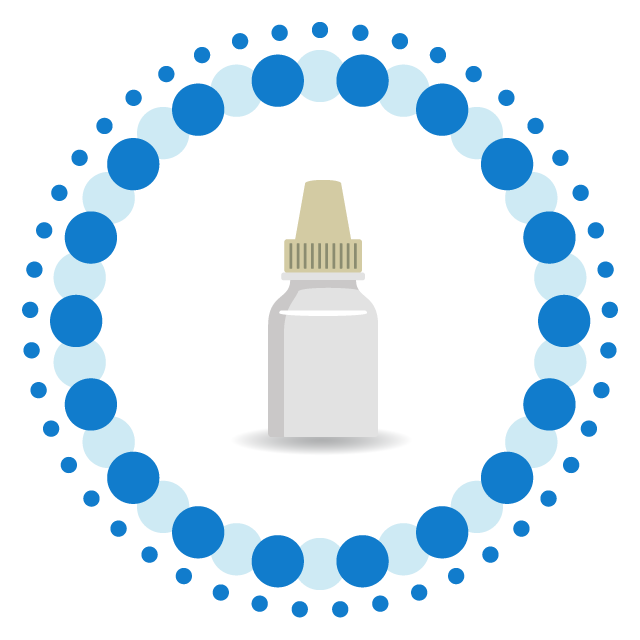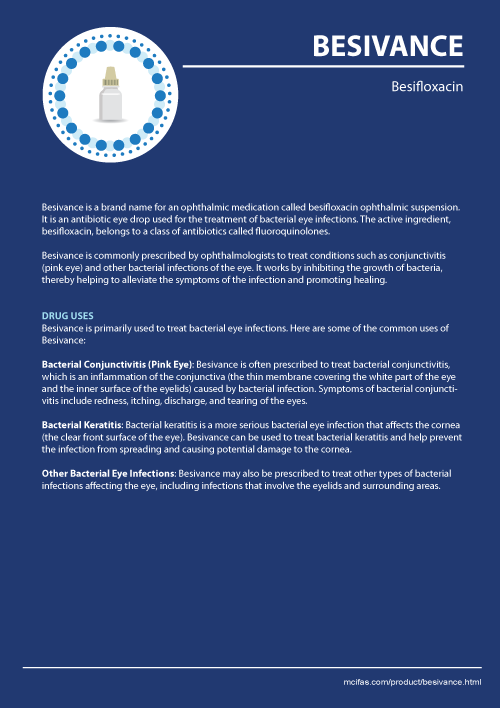Besivance Prescribing Information
Besivance is a brand name for an ophthalmic medication called besifloxacin ophthalmic suspension. It is an antibiotic eye drop used for the treatment of bacterial eye infections. The active ingredient, besifloxacin, belongs to a class of antibiotics called fluoroquinolones.
Remedy is commonly prescribed by ophthalmologists to treat conditions such as conjunctivitis (pink eye) and other bacterial infections of the eye. It works by inhibiting the growth of bacteria, thereby helping to alleviate the symptoms of the infection and promoting healing.

Uses of Besivance
Besivance is primarily used to treat bacterial eye infections. Here are some of the common uses:
- Bacterial Conjunctivitis (Pink Eye): Medicine is often prescribed to treat bacterial conjunctivitis, which is an inflammation of the conjunctiva (the thin membrane covering the white part of the eye and the inner surface of the eyelids) caused by bacterial infection. Symptoms of bacterial conjunctivitis include redness, itching, discharge, and tearing of the eyes.
- Bacterial Keratitis: Bacterial keratitis is a more serious bacterial eye infection that affects the cornea (the clear front surface of the eye). Besivance can be used to treat bacterial keratitis and help prevent the infection from spreading and causing potential damage to the cornea.
- Other Bacterial Eye Infections: Remedy may also be prescribed to treat other types of bacterial infections affecting the eye, including infections that involve the eyelids and surrounding areas.
Dosage
The general recommended dosage for most common bacterial eye infections is as follows:
For Adults and Children (1 year of age and older):
Bacterial Conjunctivitis (Pink Eye):
- Instill one drop into the affected eye(s) three times a day (approximately every 8 hours) for 7 days.
Bacterial Keratitis:
- Instill one drop into the affected eye(s) hourly for the first two days, then one drop every 2 hours while awake on days 3 through 7. After the first week, continue treatment with one drop every 4 hours while awake for an additional 7 days.
Keep in mind that the dosages provided here are general guidelines and may not apply to every individual. Your doctor will determine the appropriate dosage based on factors such as the severity of the infection, your medical history, and other considerations.
Side Effects of Besivance
Besivance can have side effects, although not everyone will experience them. Common side effects are usually mild and temporary. Here are some potential side effects:
Common Side Effects:
- Eye irritation or discomfort
- Eye redness
- Blurred vision
- Eye itching
- Dry eyes
- Eye discharge
Less Common Side Effects:
- Eye pain
- Sensation of something in the eye
- Watery eyes
- Increased sensitivity to light
- Foreign body sensation
- Headache
Rare but Serious Side Effects:
- Allergic reactions, such as rash, itching, swelling, severe dizziness, or trouble breathing
- New or worsening eye symptoms
- Eye inflammation or worsening of pre-existing eye conditions
If you have a known sensitivity or allergy to besifloxacin or other fluoroquinolone antibiotics, you should not use Besivance.
What to avoid while on Besivance
While using Besivance, there are a few things you should consider to ensure the effectiveness of the medication and minimize the risk of any adverse effects:
- Contact Lenses: It's generally recommended to avoid wearing contact lenses while using Besivance. If you need to wear contact lenses, remove them before applying the eye drops and wait at least 15 minutes before reinserting them. Contact lenses can absorb the medication and reduce its effectiveness.
- Other Eye Medications: If you are using other eye medications, including prescription eye drops, over-the-counter eye drops, or ointments, consult your doctor or ophthalmologist about the appropriate timing for using these medications in conjunction with Besivance. Some medications may interact with each other or affect the absorption of Besifloxacin.
- Proper Hygiene: Make sure to wash your hands thoroughly before using Besifloxacin. This helps prevent introducing additional bacteria or contaminants into your eyes.
- Sharing Medication: Do not share your eye drops with others, even if they have similar symptoms. Sharing eye medications can lead to the spread of infections and other complications.
- Driving and Activities: Medicine can cause temporary blurred vision after administration. Avoid driving or engaging in activities that require clear vision until your vision has returned to normal.
- Allergies and Sensitivities: If you have known allergies or sensitivities to any of the ingredients in Besivance, avoid using the medication.
- Allergy History: If you have a history of allergic reactions to fluoroquinolone antibiotics, you should not use Besivance.
Contraindications of Besivance
Besivance has specific contraindications, which are situations or conditions where the medication should not be used due to potential risks or interactions. Here are the main contraindications:
- Hypersensitivity or Allergic Reaction: If you have a known hypersensitivity or allergic reaction to besifloxacin or any other ingredients in Besivance, you should not use this medication.
- Cross-Sensitivity to Fluoroquinolones: Individuals who have experienced an allergic reaction to other fluoroquinolone antibiotics (such as ciprofloxacin, levofloxacin, or moxifloxacin) may also have a higher risk of allergic reactions to Besivance, as it belongs to the same antibiotic class. If you have experienced a severe allergic reaction to another fluoroquinolone, you should avoid using this medidine.
- Eye Trauma or Injury: If you have a recent eye injury or trauma, Besivance might not be suitable for use.
- Children Under 1 Year of Age: Besifloxacin is generally not recommended for use in children under the age of 1 year. Safety and efficacy in this age group have not been well established.
Pregnancy and Besivance
There is limited systemic absorption of Besivance when used as directed for ophthalmic (eye) infections. This means that the amount of the medication that enters the bloodstream is very low, which reduces the potential for systemic effects on the body, including the developing fetus during pregnancy.
» Drug Uses (format pdf, 0.2 Mb)



